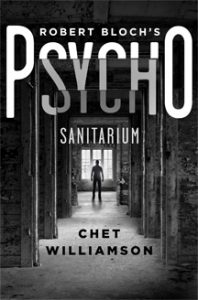In this series, I’m looking back at the books and movies of the “Psycho” franchise before its TV revival in “Bates Motel,” which will conclude its five-season run this month. (Granted, “Psycho: Sanitarium” came out after “Bates Motel” premiered, but it’s part of the book series that preceded it.)
Although Robert Bloch only wrote three “Psycho” books – in 1959, 1982 and 1990 – there are four books in Bloch’s “Psycho” series. As an unexpected surprise for Bloch fans and “Psycho” fans, “Psycho: Sanitarium” came out in May 2016 from the pen of Chet Williamson, the author of 14 previous horror or fantasy novels. Set a year after the events of the first book, when Norman is locked in the State Hospital for the Criminally Insane 20 miles from Fairvale, “Sanitarium” is a masterwork of continuity, as Williamson — a self-described “disciple of Bloch” — gives insight into Norman’s time in the ward without contradicting anything from the future books. I read it after reading Bloch’s trilogy, but a person could also read it right after “Psycho” without spoiling “Psycho II” or “Psycho House.”
In the acknowledgements, Williamson notes that the late Bloch created “a whole new genre of fiction.” I’m guessing he means the type of mystery where a reader has to account for not only clues, but also the possibility of an unreliable narrator, a trick he pulled on “Psycho” and “Psycho II.” I was prepared for this trick, and indeed I sort of figured out the answer – but not precisely.
Similar to “Bates Motel,” Norman is portrayed as a sympathetic man who is mentally sick more so than dangerous, and — following from “Psycho” — he’s 41 years old and pudgy. The reader surrogates are Dr. Felix Reed and Nurse Marie Radcliffe, the only people whom the mostly catatonic Norman will converse with. Like Reed and Marie, we feel sorry for Norman but occasionally remind ourselves, “Wait, he DID murder four people.” Norman opens up more when he starts to get visits from his long-lost twin brother Robert Newman, from whom he was separated at birth.
Williamson includes characters from other books such as Sheriff Chambers, highway patrol Captain Ballard and Dr. Steiner – plus one more surprise from “Psycho II.” His new characters are starkly drawn, including attendant Myron Gunn, who enjoys brutalizing patients. However, my fears that “Sanitarium” would be a dark slog were unfounded. Yes, most of the novel takes place in the mental hospital, but it’s not too gloomy.
Rather, the hospital itself is effectively part of the mystery, because it had been converted from a sanitarium. Williamson makes us privy to journal entries of Adolph Ollinger, a psychiatrist who was pushing Spiritual Repulsion Therapy in the 1910s. Building on the idea that religious iconography can spark the moral center of a person’s psyche, Ollinger and his team concoct spiritual visitations via costumed characters and audio. The hope is that these visions will spark a patient into being normal again, and aware of why their actions were wrong. I found this concept ingenious both in terms of plotting and believability: It seems like something from the early days of this science, where physical shocks to the system were also employed to “cure” patients.

We also get an effectively spooky basement, where the old records room is down a secondary hallway where a nurse would be trapped if the killer were to corner her. There’s also a smidgen of dark humor as we meet Norman’s fellow inmates; in offhand fashion, the author tells us what landed them in the asylum. For example, Wesley Breckenridge was a “quiet little guy who had gone nuts and chopped up his wife one Christmas Eve, then put the pieces back together so that she was sitting on the couch when family company came. … (He) sat right next to her and held her hand, which wasn’t attached to anything else.”
“Sanitarium” is crisply written, and the pacing is similar to Bloch’s. It’s missing a bit of the folksy charm that came naturally to Bloch. Still, “Sanitarium” is certainly set in 1960, and with references to physical file folders, record players and social/legal issues in a time when the Holocaust was still fresh, one can almost imagine it was written in 1960. Specific flashbacks to the Bates Motel and house might’ve been fun, rather than just the italicized conversations in Norman’s head between him and Mother – but at least the ole swamp at the back of the property makes a nice cameo.
Aside from those small qualms, “Sanitarium” is a wonderful addition to the “Psycho” book saga. And if Williamson and his publisher are willing, it doesn’t have to be the last. Much of the time before the events of “Psycho” are unchronicled, although because the film (“Psycho IV: The Beginning”) and TV (“Bates Motel”) sagas already tread this ground, there’s not a pressing need to go there. I’d like to see Williamson continue the adventures of “Psycho House’s” true-crime author Amy Haines, if he has an idea for how to posthumously tie it into Bates’ life.
If this turns out to be the end of the “Psycho” book saga, we can at least be thankful for this unexpected bonus entry.

